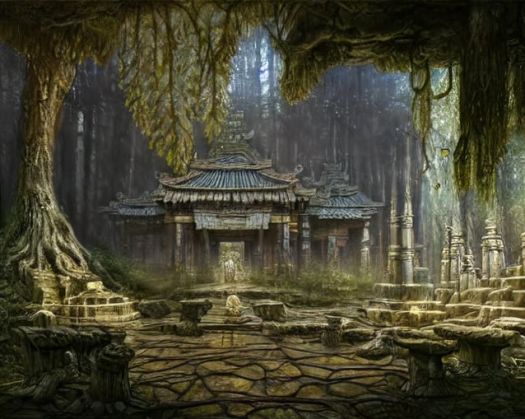Difference between revisions of "Hallucinatory Terrain (spell)"
Tao alexis (talk | contribs) |
Tao alexis (talk | contribs) |
||
| Line 1: | Line 1: | ||
[[File:Hallucinatory Terrain (spell).jpg|right|525px|thumb]] | [[File:Hallucinatory Terrain (spell).jpg|right|525px|thumb]] | ||
| − | '''Hallucinatory Terrain''' is an spell that allows an illusionary alteration to the appearance of an existing terrain, so that rocks, vegetation, the lay of the land or the presence of water bodies can be created or removed from the onlooker's perception | + | '''Hallucinatory Terrain''' is an spell that allows an illusionary alteration to the appearance of an existing terrain, so that rocks, vegetation, the lay of the land or the presence of water bodies can be created or removed from the onlooker's perception. |
{{Spelltable | {{Spelltable | ||
| Line 11: | Line 11: | ||
| level = [[Illusionist 3rd Level Spells|illusionist (3rd)]] | | level = [[Illusionist 3rd Level Spells|illusionist (3rd)]] | ||
}} | }} | ||
| + | |||
| + | The depth and size of the area affected must be assigned in cubic areas of 60 ft. each, though if the total size of the hallucinatory terrain is less than 60 ft. across (for example, a hole just three feet or three inches across is desired), then this is possible. | ||
== Unreality == | == Unreality == | ||
Revision as of 18:56, 2 October 2023
Hallucinatory Terrain is an spell that allows an illusionary alteration to the appearance of an existing terrain, so that rocks, vegetation, the lay of the land or the presence of water bodies can be created or removed from the onlooker's perception.
| Range | 40 ft. per level |
| Duration | 25 rounds per level |
| Area of Effect | 60 ft. diameter cube per level |
| Casting Time | 2 rounds |
| Saving Throw | none; see text |
| Level | illusionist (3rd) |
The depth and size of the area affected must be assigned in cubic areas of 60 ft. each, though if the total size of the hallucinatory terrain is less than 60 ft. across (for example, a hole just three feet or three inches across is desired), then this is possible.
Unreality
Whatever's meant to appear — grass, living trees, lush jungle, swamp and so on, even the aspect of natural fruits or other foods, will seem to be perfectly real, even to where they can be "picked" from the tree. Buildings and other constructions can also be made to appear.
Likewise, observers experience the unreal terrain as it's meant to feel: one can swim in the pond that's created, or climb into crevices or caves, or upon rocks, or step off a cliff while believing they're walking across even ground. This is because even if the terrain "feels" right, it isn't real. Found edibles don't provide sustenance and illusionary water can't make the observer wet. Any "effect" is actually only in the mind of the witnessing character.
Saving Throws
All those observing the spell being cast and the visible terrain being altered are free to making a saving throw; success enables observers to recognise the original terrain beneath a transparent overlay of the hallucinatory terrain, so that both can be seen at the same time. Those not making saving throw can be seen to act "silly" as they take actions of climbing, swimming, eating and so on, as the terrain continues to seem real to them.
Before any observer can come to harm, say from walking off a cliff, he or she is allowed a saving throw. In this case, success won't reveal the illusion, but it will cause the character interacting with the terrain will just "decide" to go somewhere else, or get interested in something else, and thus not walk off the cliff. A successful save may also suggest that the visible bridge is unsafe, that it won't actually support the character's weight and so on.
Limitations
The spell cannot create living creatures using the spell, nor can it blot out the existence of these creatures. Thus, denizens are visible inasmuch as they can be seen behind the hallucinatory terrain's features; moving left or right would reveal such behind a tree, for instance.
If the observer knows the terrain is inaccurate, because they are well familiar with the area, then a saving throw is allowed — the success of which would confirm the observer's suspicion that the terrain is false (though it's appearance is unchanged by this revelation). A detect illusion spell reveals the real terrain, producing the transparent visage described above.
Paradoxes
The question arises, can a character "drown" or potentially hang themselves from a hallucinatory tree, if they make the attempt. The simple answer is no. Should anything like this come about, the DM should treat the affected character as unconscious, without taking any damage, until revived. Once this is accomplished, the previously affected character can afterwards see the terrain as transparent, just as if they had detected the illusion or made save when the spell was cast before them.
The actions of others, whether they know of the terrain's true existence or not, will be interpreted by believers of the illusion as though they're acting "properly" with it. Creatures and characters will appear to wade through water toward the observer, or jump down from a rock above (even if they're on the same level as the observer) and so on. An oncoming creature that appeared to be walking through an overgrown vegetation would seem to be pushing through the branches, though they were just walking forward normally. Much of what's seen occurs strictly within the observer's mind.
Sometimes, these details may achieve some difficulty with interpretation, which the DM must reconcile.
